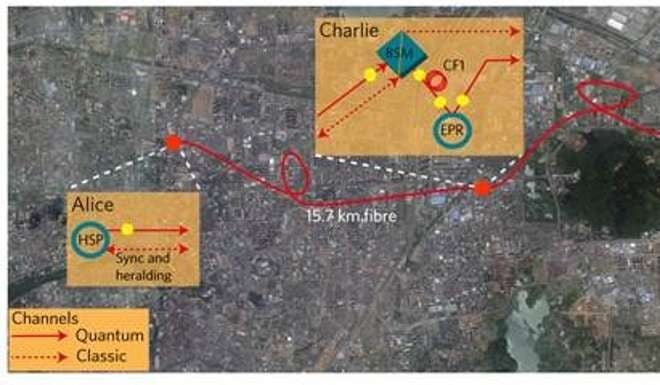
Teleportation, the next generation: Chinese and Canadian scientists closer to a quantum internet
Researchers teleport tiny photon particles across cities in breakthrough that could help future development of a faster, more secure ‘quantum internet’
Chinese and Canadian scientists say they have successfully carried out a form of teleportation across an entire city.
The two teams working independently have teleported near-identical versions of tiny particles called photons through cables across Calgary in Canada and Hefei in Anhui province.
The forms of teleported photons were destroyed in one laboratory and recreated in another more than 8km apart in the two cities through optical fibre.
Similar experiments have been carried out before, but only within the same laboratory.
A physicist not involved in either of the studies said the research was a step forward in the development of a “quantum internet”, a futuristic particle-based information system that could be much more secure than existing forms of digital data.
Quantum networks make eavesdropping almost impossible because the particles used cannot be observed without being altered.
Teleportation, the foundation for such a network, has largely been the realm of science fiction, and other scientists say the research is still a very long way from teleporting people or objects.

But in his commentary on the research in the scientific journal Nature Photonics, French physicist Frederic Grosshans said the two experiments clearly showed that teleportation across metropolitan distances was technologically feasible.
“The two papers demonstrate that the possibility of quantum [internet] networks that span a city are a realistic proposition, which is an exciting vision for the future,” Grosshans said.
Professor Zhang Qiang, one of the leaders of the Chinese team, said: “Maybe in the distant future, materials can be teleported through a fibre or even open space, too.”
Maybe in the distant future, materials can be teleported through a fibre or even open space, too
The research was carried out by scientists at the University of Science and Technology of China and the University of Calgary and their papers were published in the journal on Monday.
The research concentrates on the behaviour of particles at a subatomic, or quantum level.
Researchers have long known that a photon particle can be split in two and yet the pair are still “entangled”, which means that any change in the state of one immediately affects the other, although how this happens is still unknown.
The two papers demonstrate that the possibility of quantum [internet] networks that span a city are a realistic proposition, which is an exciting vision for the future
This, in theory, means it could be possible to transmit information by manipulating entangled photons, but various factors, including fluctuating temperatures, can interfere with the process over longer distances outside the laboratory.
The researchers used sophisticated equipment to counter these and other problems, allowing the Chinese team, led by Professor Pan Jianwei and Professor Zhang, to achieve “full” quantum teleportation of photons over a optical fibre network 12.5km apart.
The Canadian team led by Professor Wolfgang Tittel also teleported the particles over 8.2km. The teleported photons were a virtual copy of the original.
A team at the National Institute of Standards and Technology in the US reported last year that it had achieved quantum teleportation over a fibre optical network more than 100km in length, but the whole cable was coiled within a laboratory.
Scientists have also teleported photons through the air over 100km, but the technology can only be used at night and in remote areas because too many of the particles are generated by other sources including natural light.Using a cable shields the photons from interference and is viewed by researchers as a more practical way of harnessing the technology.
The Chinese and Canadian teams used different approaches to carry out their experiments. The Chinese team demonstrated a fuller version of the quantum network with higher reliability, but the Canadian approach was more efficient, according to Grosshans.
The Chinese method “comes at the price of a low rate of two teleported photons per hour, which would strongly limit its practical applications if it could not be improved”, he said.
The Canadian method “allows a faster teleportation rate of 17 photons per minute”, but their low accuracy during transmission “also limits its immediate practical applications”.
Zhang at the University of Science and Technology of China, said the team’s work was only a small step towards the construction of a quantum network.
Many technical hurdles, such as storage for the extremely fragile quantum data, remained and it was difficult to predict when a global quantum internet would be operational.
Grosshans said a useful quantum computer was still a few decades away and “the first ones, whether they will be built in 2030 or 2070 would be very expensive machines”.
China is at the forefront of research into quantum communications.
It is carrying out experiments on a satellite launched last month as part of efforts to develop a communications system that cannot be cracked by hackers.
The experiments involve attempting to transmit information through photons from the satellite to earth.

